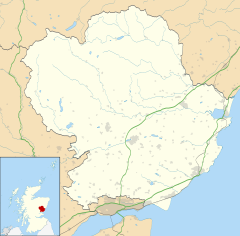
A torc, also spelled torq or torque, is a large rigid or stiff neck ring in metal, made either as a single piece or from strands twisted together. The great majority are open at the front, although some had hook and ring closures and a few had mortice and tenon locking catches to close them. Many seem designed for near-permanent wear and would have been difficult to remove. Torcs are found in the Scythian, Illyrian, Thracian, Celtic, and other cultures of the European Iron Age from around the 8th century BC to the 3rd century AD. For the Iron Age Celts, the gold torc seems to have been a key object. It identifies the wearer as a person of high rank, and many of the finest works of ancient Celtic art are torcs. The Celtic torc disappears in the Migration Period, but during the Viking Age torc-style metal necklaces, now mainly in silver, came back into fashion. Torc styles of neck-ring are found as part of the jewellery styles of various other cultures and periods.
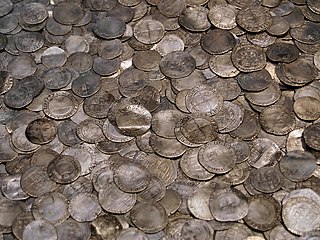
A hoard or "wealth deposit" is an archaeological term for a collection of valuable objects or artifacts, sometimes purposely buried in the ground, in which case it is sometimes also known as a cache. This would usually be with the intention of later recovery by the hoarder; hoarders sometimes died or were unable to return for other reasons before retrieving the hoard, and these surviving hoards might then be uncovered much later by metal detector hobbyists, members of the public, and archaeologists.

Bonar Bridge is a village on the north bank of the Kyle of Sutherland to the west and the Dornoch Firth to the east in the Parish of Creich in the Highland council area of Scotland.

Stanwick Iron Age Fortifications, a huge Iron Age hill fort, sometimes but not always considered an oppidum, comprising over 9 kilometres (5.6 mi) of ditches and ramparts enclosing approximately 300 hectares of land, are situated in Richmondshire, North Yorkshire, England. Whether Stanwick was the stronghold of Venutius or Cartimandua, or perhaps of them both for a brief time before their acrimonious split some time after 51 AD, it is certain that this settlement was one of the most important in Brigantia, the Brigantes kingdom during the early stages of the Roman occupation of Britain. The site is a scheduled monument.
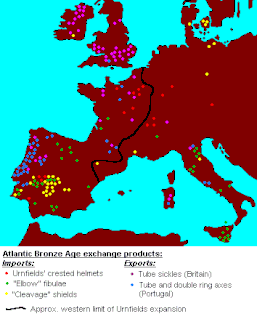
The Atlantic Bronze Age is a cultural complex of the Bronze Age period in Prehistoric Europe of approximately 1300–700 BC that includes different cultures in Britain, France, Ireland, Portugal, Spain, Scotland, and Wales.
The Migdale Hoard is a group of early Bronze Age jewellery discovered by workmen blasting a granite knoll behind Bonar Bridge, Scotland, near what is known as "Tulloch Hill" in May 1900.

Tievebulliagh is a 402-metre-high (1,319 ft) mountain in the Glens of Antrim, Northern Ireland. It forms part of the watershed between Glenaan to the north and Glenballyemon to the south. It is situated about 4.4 km from Cushendall.

Zsujta is a village in Borsod-Abaúj-Zemplén county, Hungary. A large Bronze Age hoard of weapons and cart fittings, was discovered at the village in the late 19th century. The hoard is now in the collections of the British Museum, London.
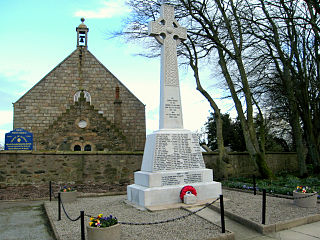
Tarves, Aberdeenshire, is a small village, situated in the Formartine area of North East Scotland and lies between Oldmeldrum and Methlick.

The Stirling torcs make up a hoard of four gold Iron Age torcs, a type of necklace, all of which date to between 300 and 100 BC and which were buried deliberately at some point in antiquity. They were found by a metal detectorist in a field near Blair Drummond, Stirlingshire, Scotland on 28 September 2009. The hoard has been described as the most significant discovery of Iron Age metalwork in Scotland and is said to be of international significance. The torcs were valued at £462,000, and after a public appeal were acquired for the National Museums of Scotland in March 2011.

Saka is a village in Toila Parish, Ida-Viru County in northeastern Estonia.

Prehistoric art in Scotland is visual art created or found within the modern borders of Scotland, before the departure of the Romans from southern and central Britain in the early fifth century CE, which is usually seen as the beginning of the early historic or Medieval era. There is no clear definition of prehistoric art among scholars and objects that may involve creativity often lack a context that would allow them to be understood.

Broholm is an estate and manor house in the parish of Gudme, some 10 km (6.2 mi) northeast of Svendborg, on the Danish island of Funen. The private estate has 591 ha, 168 ha being arable, 395 ha being forest and 28 ha in meadows. There are ten rental properties on the estate as well as an equestrian center with outdoor and indoor riding arenas. Denmark's biggest gold hoard from the Migration Period was found at Broholm.
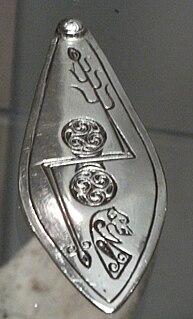
Norrie's Law hoard is a sixth century silver hoard discovered in 1819 at a small mound in Largo, Fife, Scotland. Found by an unknown person or persons, most of the hoard was illegally sold or given away. Remaining items of the hoard were found later at the mound, and were turned over to the landowner, General Philip Durham. The surviving 170-piece hoard now is in the National Museum of Scotland. The treasure consists mostly of hacksilver and includes four complete silver pieces.

The Buddhapad Hoard or Buddam Hoard is a large cache of Buddhist sculptures found near the town of Buddam in Andhra Pradesh, southern India. Since 1905, it has formed an important part of the British Museum's South Asian collection. Dating from 6th-8th centuries AD, the style of craftsmanship fuses the northern influences of the Gupta period with the southern traditions of the Deccan, which in turn greatly influenced Buddhist art in South East Asia in subsequent centuries.

The Galloway Hoard, now in the National Museum of Scotland, is a hoard of more than 100 gold and silver objects from the Viking Age discovered in the historical county of Kirkcudbrightshire in Dumfries and Galloway in Scotland in September 2014. Found on Church of Scotland land, the hoard has been described by experts as "one of the most significant Viking hoards ever found in Scotland". It was discovered by a metal detector enthusiast who reported the find to the authorities. A county archaeologist carried out an excavation which unearthed a rich and unusually varied collection of jewellery from the Viking world, Anglo-Saxon England and elsewhere in Europe. It is thought that the hoard was buried some time in the mid-ninth or tenth century, though it is not known why it was buried.
A Bronze Age hoard was found near Peebles, Peeblesshire, Scotland in June 2020. It was discovered by Mariusz Stepien, a 44-year-old hobby metal detectorist, and the find was announced on 10 August 2020. As of 13 August 2020 no official name for it had been announced.
The Horsehope or Horse Hope Craig Hoard is a Bronze Age hoard found in Scotland in 1864.
